Lectric ONE Review | Stellar Tech At A Shockingly Low Cost!
This diminutive commuter e-bike punches well above its weight class in terms of tech, functionality, and power—all at an approachable price.
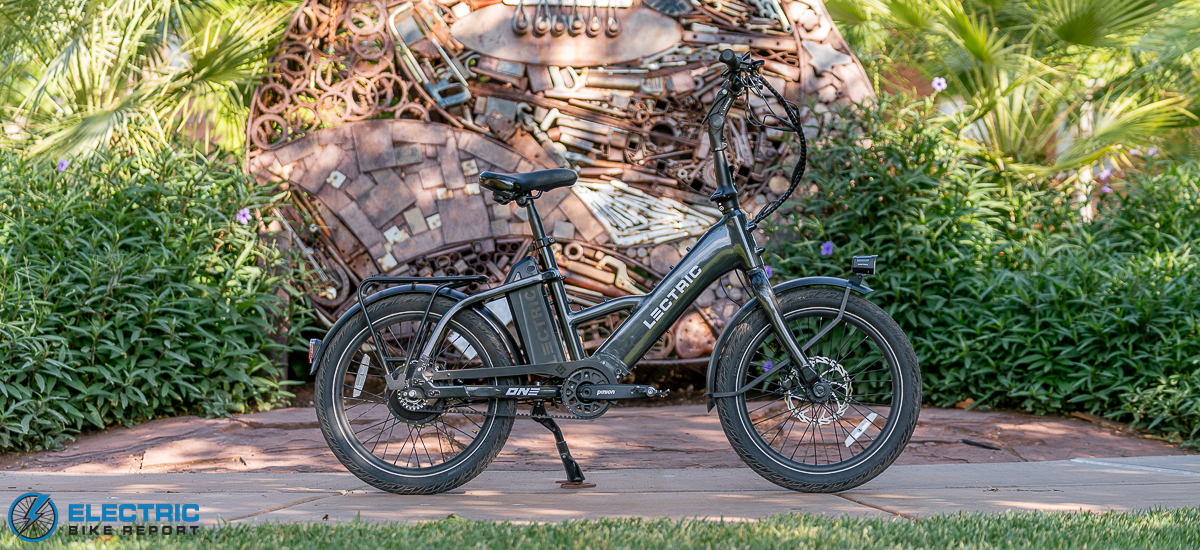
Like most industries, the e-bike market is often shaken when new technology is debuted or when a new model is priced well below the expected and established threshold based on its specs and features.
Lectric, a brand whose reputation was defined by breaking the norm with its highly affordable XP line of folding e-bikes, is no stranger to shaking things up. The ONE is the brand’s latest instance of redefining what is possible at a specific price point—and potentially one of its most impactful.
The Lectric ONE is a commuter e-bike packed with unexpected technology for its price just north of $2k. Most notably, it features a 6-speed Pinion gearbox with electronic shifting and automatic downshifting. It also sports a Gates Carbon belt connecting the gearbox to its lively 750W rear hub motor, making for a smooth, quiet, and low-maintenance experience.
Additionally, the ONE employs a cadence sensor to trigger its motor, using an array of 96 magnets (many others use just 12) for extremely rapid, responsive engagement. Like many of Lectric’s other e-bikes, the bike uses the brand’s PWR programming, which creates a more natural, analog-like pedal experience than traditional speed-based systems.
We were floored when the bike was announced, and our initial test rides showed serious promise. Did the bike hold up to our excellent first impressions? Read our full review below to find out!
Class 2 (throttle to 20 mph)
Class 3 (pedal assist to 28 mph)
 Pros
Pros- The ONE offers amazing value with killer tech for its price! A 6-speed C1.6 Pinon gearbox offers electronic, semi-automatic shifting and is paired with a 750W motor using a Gates Carbon belt.
- The bike has quick, responsive motor engagement and a natural ride feel thanks to Lectric’s current-based PWR programming and a cadence sensor with 96 magnets.
- We found the bike to be agile and lively due to its relatively compact design and 20” wheels.
- It’s extremely low-maintenance thanks to the Pinion gearbox and Gates Carbon belt. The gearbox needs only an annual oil change, while the belt will last at least twice as long as a standard chain.
- The bike’s size is deceptive; it comfortably accommodates a wide range of riders (5’ 2” to 6’ 4”) with the ability to tailor fit through the adjustable stem.
- It’s portable and storable with a low frame, collapsing stem, quick-release pedals, and front tire. The ONE weighs a manageable 61 lbs with the Long-Range battery option.
- A cruise control function allows the motor to power the bike at a set speed without the need to hold the throttle.
- The bike feels high-tech with Pinion Smart.Shift app integration and belt tension checking through the Gates app.
 Cons
Cons- We like the new color display but found the bar-based battery charge indicator to be inconsistent. We challenge Lectric to use a percentage-based display to alleviate range anxiety.
- Battery:48V, 672 Wh
- Display: Color LCD, USB-A port
- Motor: Sutto 750W rear-hub motor (1310W peak), 85 Nm torque, Stealth M24 technology
- Headlight:Integrated LED
- Taillights:Integrated LED, brake-activated
- Pedal Assist: PAS 1-5, PWR current-based programming
- Claimed Range: Up to 60 miles
- Throttle:Thumb throttle
- App:Pinion Smart.Shift
- UL Certification:UL2271, UL2849 Certified
- Claimed weight: 55 lbs.
- Tested Weight: 61.2 lbs
- Rider height range: 5’2” – 6’4”
- Total payload capacity: 330 lbs.
- Brakes: Hydraulic disc brakes, 2-piston calipers, 180mm rotors (1.8mm thick)
- Fenders: Alloy
- Fork: Rigid aluminum
- Frame: 6000-series aluminum
- Drivetrain:Pinion C1.6 gearbox, Gates CDC 113T belt, 39T Chainring, 24T Cog
- Grips: Lock-on ergonomic rubber
- Saddle: Custom sport saddle
- Handlebar:660 mm, low-rise
- Kickstand: Chainstay-mounted
- Pedals: Quick-release platform
- Tires: 20×2.5” Chaoyang city tires, 3mm Hippo Skin, Aramid Floc Breaker, Shark Skin sidewall protection
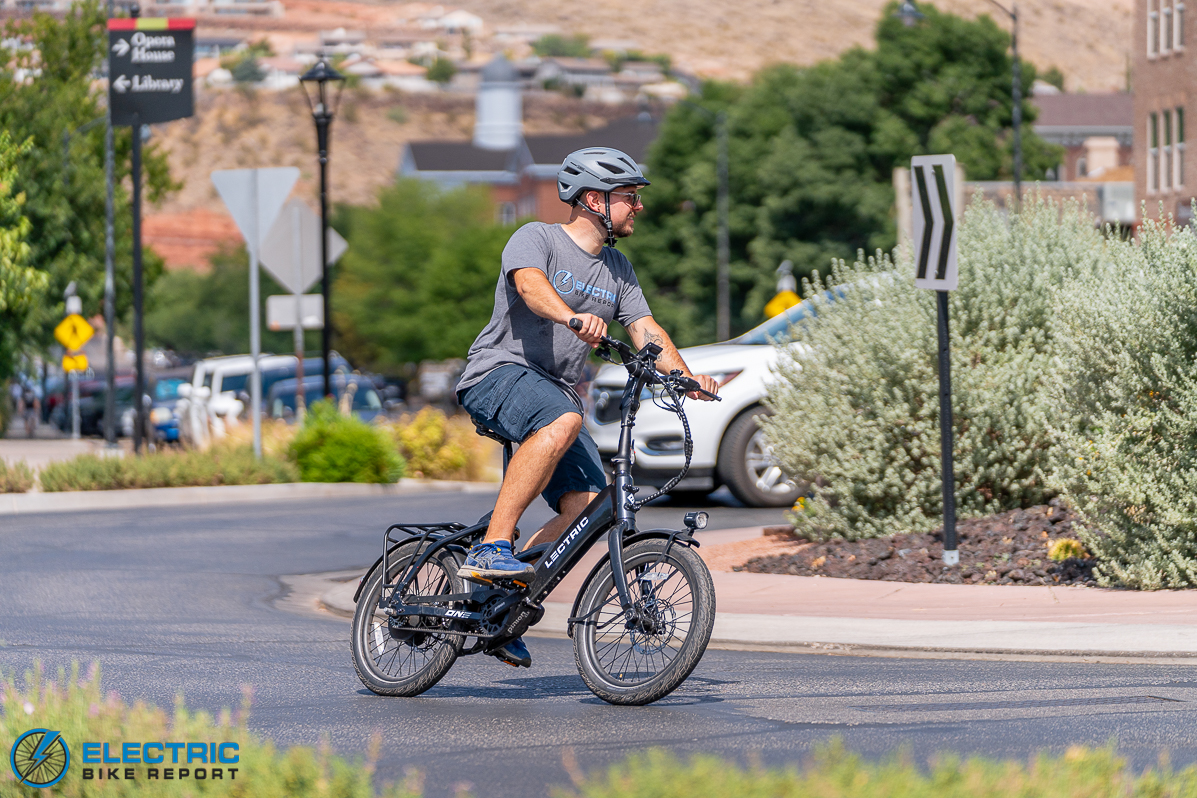
We found the ONE to be extremely nimble due to its relatively short wheelbase and 20” wheels.
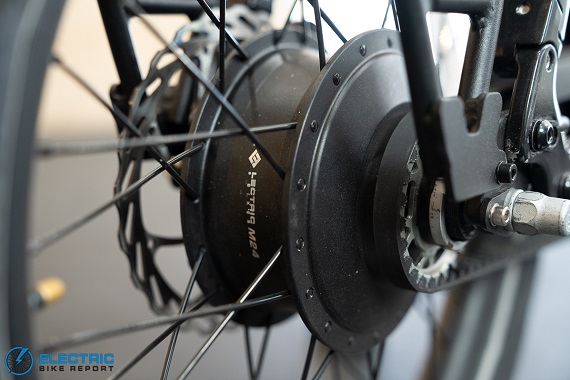
With a 750W hub motor (1310W peak), the ONE feels powerful and lively, delivering near-immediate assistance.
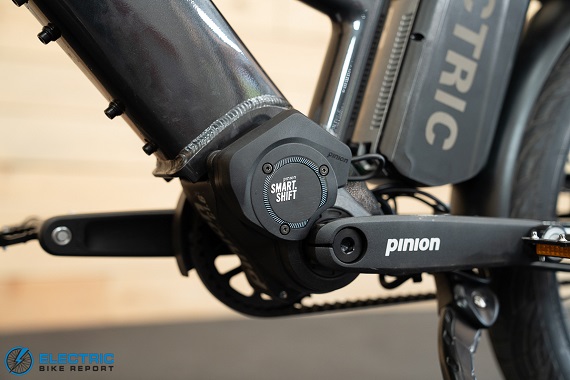
The 6-speed Pinion C1.6 gearbox offers smooth, responsive electronic shifting—even under load.
Lectric ONE Review: Speed Test
Our results, which make up the ONE’s speed profiles, are shown in the graphic above.
Ideally, we hope to see a smooth angled line created by our data points, which results from consistent increases in speed between each pedal assist system (PAS) setting. The ONE’s Class 2 data follows this pattern in PAS 1, 2, and 3, but on flat ground, it reached the Class 2 limit earlier than expected and could not exceed 20 miles per hour in PAS 4 and 5.
To clarify a point I made earlier regarding Lectric’s PWR programming, the ONE’s default settings use traditional speed-based limits in PAS 1 and 2. In PAS 3, 4, and 5, its speed is not limited; instead, only the amount of power the motor puts out is capped. Users can change the bike’s settings to allow PAS 1 and 2 to use the PWR-style assist if desired.
The Class 3 speed profile showed improvement, with four relatively consistent steps up in speed and only two PAS levels with the same speeds. Overall, this is a good result, though we would have preferred faster speeds across all settings in this portion of the test when compared to the Class 2 data.
As it is, this test showed that the bike has either three or four assist levels for flat ground (depending on whether the bike is in Class 2 or Class 3 mode) and then either one or two higher-powered settings for tackling hills. This sort of pattern is not uncommon; see the Hill Test section later for more information about its performance on a slope.
I also tested the ONE’s throttle acceleration and found it to be quick, peppy, and fun. The bike sped forward and reached its maximum speed (20 mph) in no time! Users who prefer a less intense feel can adjust the force of the acceleration through the bike’s settings menu; there are four options to choose from, with the default being the second strongest.
Overall, the ONE proved fast, fun, and functional in this test, even if there was some room for improvement in its speed profiles.
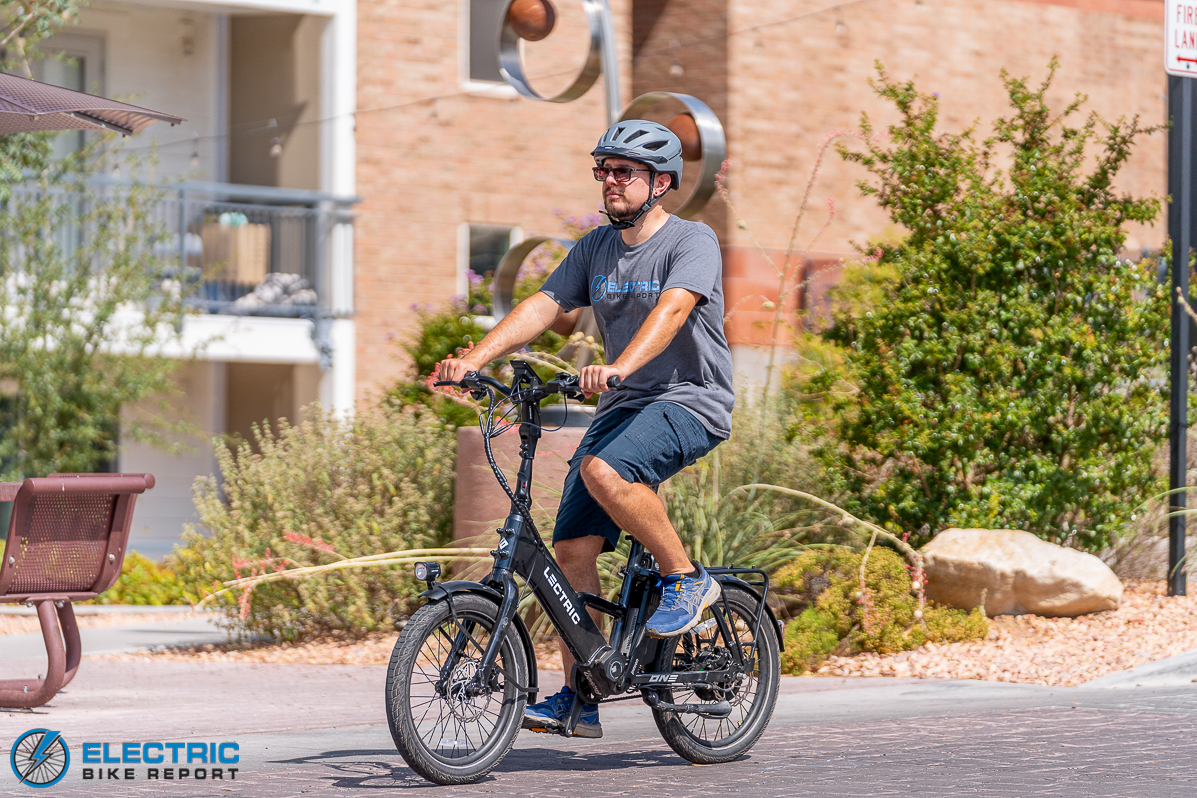
At a glance, you might not expect the ONE to fit tall riders. It’s recommended to fit those from 5’2” to 6’4”!
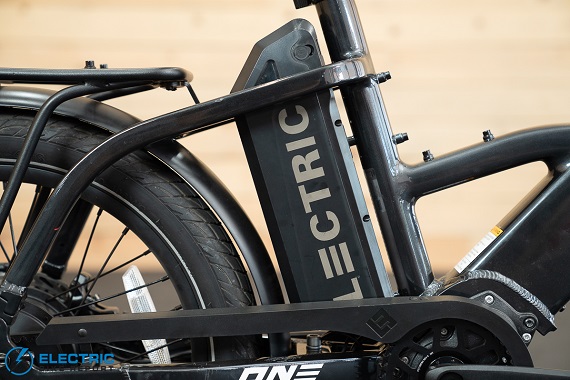
The bike’s UL-Certified 672-Wh battery sits behind its seat tube and can be easily removed.
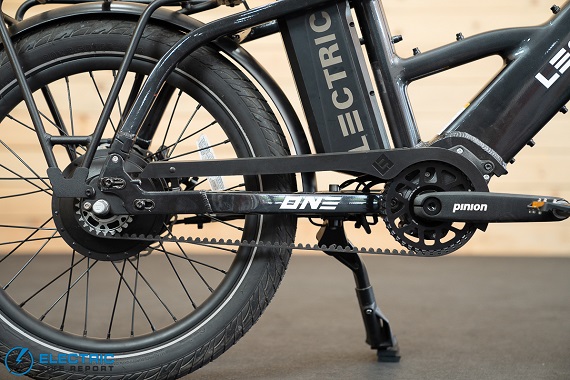
A Gates Carbon belt connects the bike’s 750W motor with the Pinion gearbox.
Lectric ONE Review: Range Test
Our testing method and Range Test results are shown in the graphic above. To clarify, we tested the bike in its standard Class 2 mode (as it ships). Riders using the bike in Class 3 mode should expect less range due to the energy requirements of riding at higher speeds.
Both of the ONE’s results are relatively average when compared to similar commuter e-bikes we’ve tested; at the time of writing, commuters average 30.7 miles on the high-PAS test and 57.6 miles on the low-PAS test.
We’re satisfied with these results—especially when considering the ONE’s motor and battery specs. Based on its 672-Wh battery and 750W motor, we expected our PAS 5 test to last roughly 15 miles. Our real-world test showed better-than-expected efficiency, though it also suggested Lectric’s advertised range of up to 60 miles may be somewhat hopeful.
Touching back on the adjustable acceleration I mentioned in the Speed Test section above, we tested the bike using the lowest of its four settings (0-3, with 0 being the most forceful). We noticed that the bike burned through battery charge quickly when using the highest settings (its default is 1), so we recommend using 2 to balance fun and efficiency or 3 to prioritize range.
Most riders who commute to work or school tend to have less than a 20-mile ride, so the ONE’s Range Test results make it practical for daily use. The ability to go over 30 miles at Class 2 speeds should cover a lengthy round-trip commute, while we appreciate the option to squeeze over 50 miles of distance in extreme cases.
In summary, the ONE performed well in our range test, though its results will vary depending on its settings and how it is used. Those needing to maximize the bike’s range may need to do a bit of tuning to achieve their preferred results.
Lectric ONE Review: Hill Test
As with our previous test sections, the Lectric ONE’s Hill Test results are shown in the graphic above, along with an explanation of our testing method.
Compared to other e-bikes we’ve tested in the commuter category, the ONE’s performance was relatively average when pedaling; those bikes averaged 1:21 vs Lectric’s 1:23. However, the ONE was significantly faster than average in the throttle portion with its result of 1:30 vs the commuter average of 1:44.
To be clear, we do not consider our Hill Test a race. The goal of the test is to ensure that the bike can effectively climb steep hills. Thus, the ONE succeeded in both portions of the test while exceeding the performance of many of its peers when relying on throttle power.
These results matched our expectations based on the ONE’s motor, which peaks at 1,310W with 85 Nm of torque. Our methodology suggests that peak wattage affects throttle results most, while torque seems to affect pedaling more. The ONE’s results back that up, as its torque is relatively average, while its peak wattage is higher than average for a commuter.
Our results also jive with our previous experience with Lectric, as the brand’s bikes tend to feel powerful, allowing riders to confidently tackle hills with ease.
I performed separate testing at our secondary location, called Pilot Hill, with the goal of ensuring that each of its PAS settings had measurably different power levels. Pilot Hill is less extreme than Hell Hole, though still effective as a testing location, as it is not likely to be a hill most riders would pedal up willingly.
I was definitely impressed with the bike’s climbing power; it made short work of the path both when throttling and pedaling. In Class 2 mode, I finished the throttle test in 1:09 and the PAS 5 pedal test in 1:04. Using PAS 4, I pedaled to the top in 1:10, and in PAS 3, my time was 1:35.
This shows that the power level of PAS 4 is much closer to PAS 5 than PAS 3 is to PAS 4, which means that many riders may not need the maximum power output when dealing with average to large hills. Sticking with a lower assist level will help to extend the bike’s range.
I also performed Class 3 tests at Pilot Hill in PAS 4 and 5 since these also shared the same speeds in our Speed test. My results in both instances were just 1 second faster than the Class 2 tests mentioned above, showing that the bike does not lack climbing power in Class 2 mode.
To summarize, riders should expect easy climbing on the ONE, whether choosing to throttle or pedal over hills.
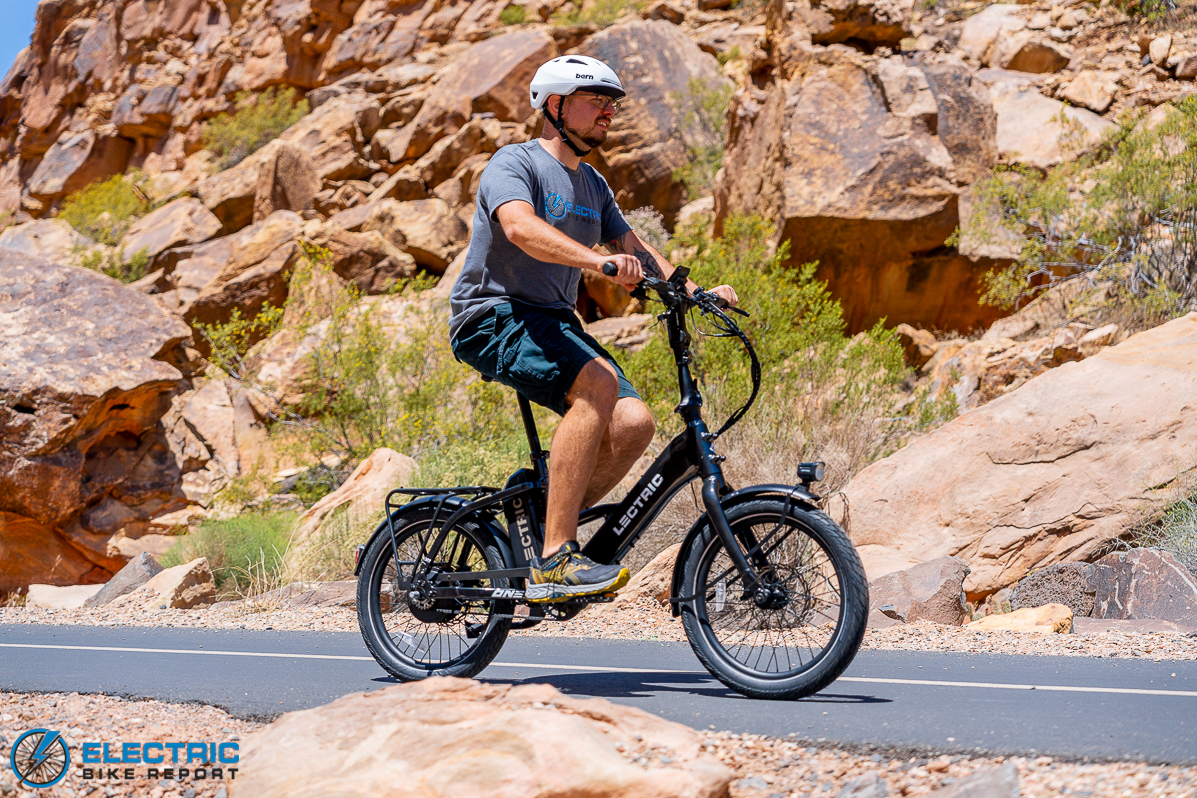
With the ability to convert between Class 1, Class 2, and Class 3 modes, the ONE is likely to match the preferences and local regulations of most riders.
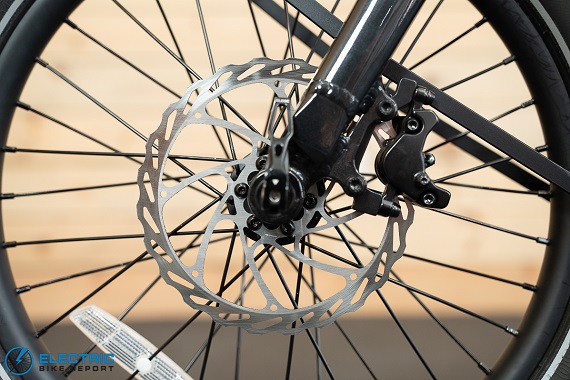
The bike’s hydraulic disc brake system pairs 2-piston calipers with 180mm rotors.
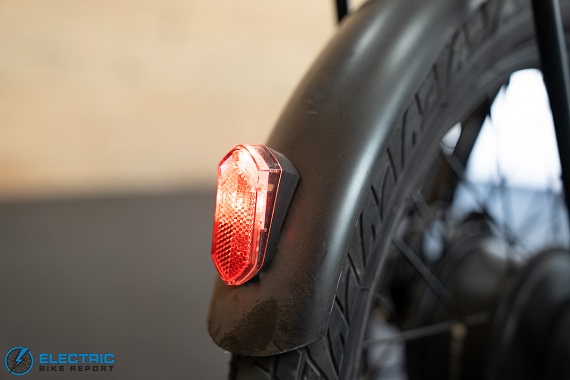
The fender-integrated tail light also serves as a brake light.
Lectric ONE Review: Brake Test
The ONE averaged a stopping distance of 17’9” in our Brake Test, which is significantly better than average when compared to the 22’7” result of other commuter e-bikes we’ve tested.
A combination of factors likely affected the bike’s performance. These include its weight and the width of its tires, but also potentially a few others.
At 61 pounds, the ONE is roughly 5 pounds lighter than average when compared to other e-bikes in the commuter category, so it is slightly easier to slow down. Additionally, while it’s not uncommon for commuters to have tires exceeding 2” wide, not many reach the ONE’s 2.5” width. This extra grip likely slowed it faster, too.
It is also entirely possible that its center of gravity was a factor, as most of the ONE’s weight sits extremely low. Our testing also suggests that its battery placement behind the seat tube may have also helped; many bikes we have reviewed with similar battery placement have shorter-than-average stopping distances.
The bike uses a hydraulic disc brake system with 2-piston calipers and 180-mm front and rear rotors. While unlabeled, the system resembles brake systems from Tektro, so it is possible that a name-brand manufacturer is responsible for its construction. This would also support its good performance.
In my personal testing, the ONE’s braking felt safe, powerful, and quick. The brake system had plenty of bite with fast deceleration (somewhat on the aggressive side), and it was also smooth and quiet. The wheels never locked up, but the bike could fishtail somewhat depending on how I was balanced, but not to an unusual or unsafe degree.
In summary, the ONE has great brakes with reliable stopping power. Our approval is well-earned in this test section!
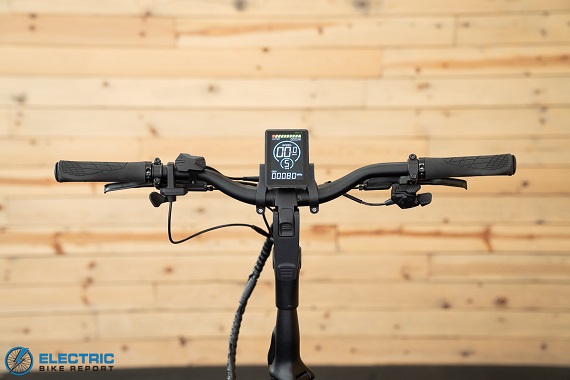
The ONE’s cockpit hosts a color LCD and a set of 660-mm low-rise handlebars on a quick-adjust stem.
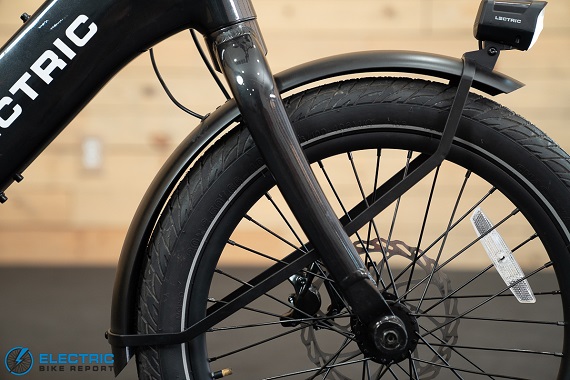
A rigid fork gives the ONE crisp, predictable handling that pairs well with its agile 20” wheels.
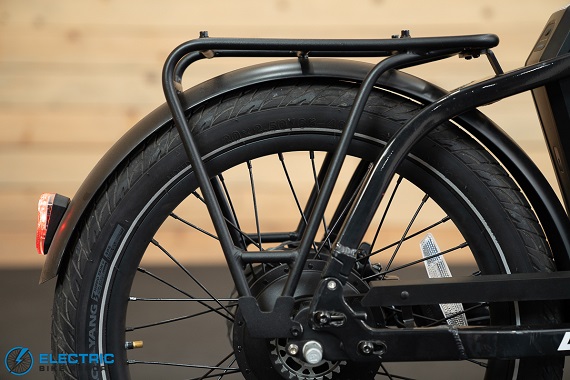
The ONE’s rear cargo rack can carry up to 30 lbs and is compatible with optional panniers.
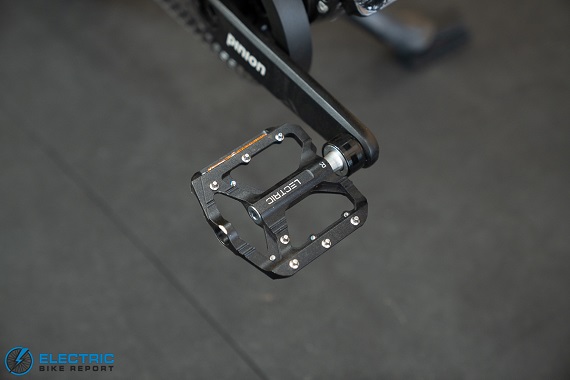
We liked the grippy, durable, custom-branded quick-release pedals.
Lectric ONE Review: Ride Quality
So far, the Lectric ONE has shown solid performance in our testing, but ride quality—how a bike feels to ride—is where it truly shines. In this section, we will examine its fit, comfort, handling, operation and interface, motor engagement, and more.
Sizing and fit are two essential components of a comfortable ride. While the one may appear small (it sits low and has a relatively short wheelbase), its geometry is surprisingly accommodating; the bike fits riders from 5’2” to 6’4”.
At 5’11”, I was comfortably within its fit range, having full leg extension and a relatively upright riding position. The bike offers 8.5” of adjustment in saddle height (there was roughly 1” beyond my preferred position) and a quick-adjust stem. With this latter component, riders can adjust the reach and handlebar height to suit their needs.
While technically not a folding e-bike, the ONE has many features that make it much more portable than most full-size commuters. Its collapsible stem allows the handlebars to fold down, reducing the bike’s height. Its front wheel can easily be removed thanks to a quick-release thru-axle. The bike also has quick-release pedals to reduce its width.
I found the bike to be comfortable, thanks to its ergonomic rubber grips, adjustable riding position, and grippy pedals. While there is no suspension, the bike’s 20×2.5” street tires offer some much-appreciated cushioning and shock absorption.
The absence of a suspension also improves the ONE’s already excellent handling, lending it a reliable and certain feel when cornering. Thanks to the bike’s wheelbase and small wheels, it feels extremely agile and maneuverable, with a remarkably small turning radius and quick steering. It’s truly a blast to zip around on!
It is worth pointing out that I often found myself striking my heels on the bike’s chain stays, though I do have rather large feet. With US men’s size 12 shoes, I needed to scoot my feet forward on the pedals more than I usually prefer, though I adapted to the change rather quickly.
The bike’s Pinion gearbox and electronic shifting are two primary contributors to its excellent ride quality. In terms of feel and function, it would be difficult to find a more user-friendly system; the Pinion system allows for quick, snappy shifting even when pedaling uphill or at a standstill. It also feels and sounds well-made and high-tech.
Once paired with the Pinion Smart.Shift app, users can choose to activate one of two semi-automatic shifting modes. With Start.Select active, the gearbox will automatically downshift to a chosen gear after a short delay upon stopping. The Pre.Select function incorporates this feature but also downshifts when coasting to match a desired cadence.
Additionally, the pairing of this system with a Gates Carbon belt makes the experience of owning the bike extremely low-maintenance. The belt is rated to last twice as long as a chain while being smoother, quieter, and cleaner (no lubrication is needed). The Pinion system itself needs an oil change after every year or 6,200 miles, whichever comes first.
While the Pinion app is essential, the Gates Carbon Drive Belt Tension Tool app is another useful thing to download, as it allows owners to check the belt’s tension by strumming it like a guitar string.
I found the ONE’s cockpit and user interface to be straightforward and uncomplicated; the throttle lever and button panel sit on the left handlebar, while the shifters are on the right. I liked the central color LCD, though this was not without its quirks.
In previous sections, I mentioned that the bike could burn through battery charge relatively quickly when its acceleration force was set too high. The bike’s battery charge readout made predicting the remaining range difficult, as it fluctuated often based on how I was riding. We’d prefer a display with a percentage-based charge indicator for better reliability.
Otherwise, I thoroughly enjoyed the ONE’s lively and powerful motor, responsive feel, nimble handling, and super-cool tech. Minor hiccups aside, the ONE is a seriously unique bike with excellent ride quality!
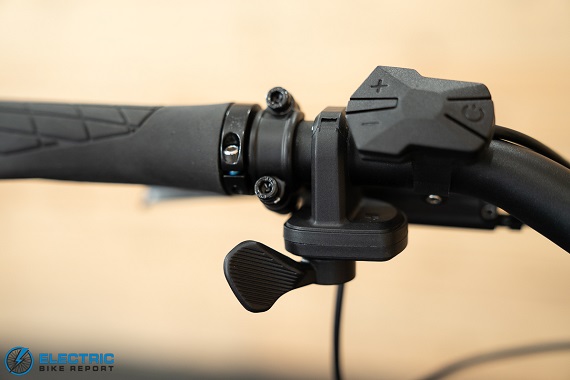
The thumb throttle lever is mounted to the left handlebar near the button pad.
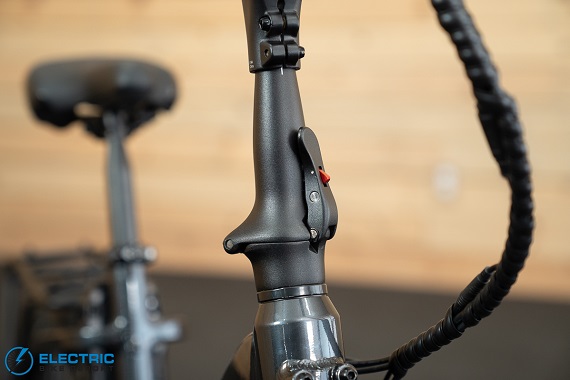
A collapsible stem reduces the ONE’s height for easier transport or storage.
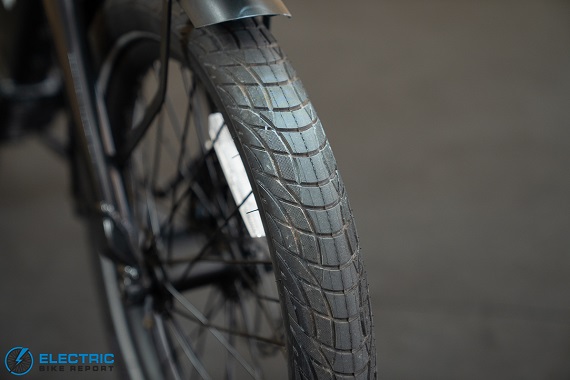
The ONE’s 20×2.5” street tires provide stability and traction and also serve as the bike’s suspension.
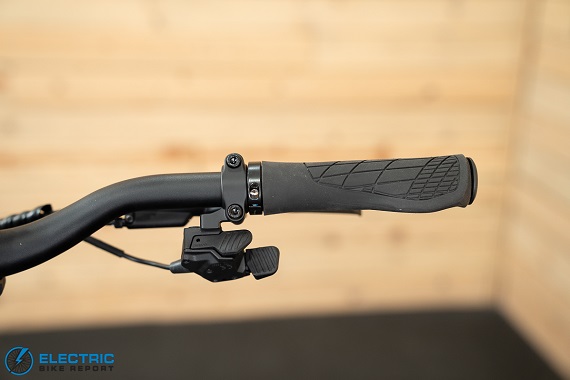
The shift levers for the Pinion gearbox sit on the right handlebar next to the ergonomic rubber grip.
Lectric ONE Review: Summary / Where to Buy
My job is always much easier and more enjoyable when reviewing e-bikes like the ONE. With good performance and so many uncommon defining features, I can sing its praises without being concerned about overloading my review with critique. While the ONE is not a perfect bike, generally speaking, Lectric knocked this one (pun intended) out of the park!
The included Pinion system is awesome, as it makes the ONE incredibly easy to operate and own. Its electronic shifting feels responsive, its automatic downshifting just works, and in combination with a belt drive, it greatly reduces the need for regular maintenance (though it’s important to keep up with brake service and check the belt tension).
The ONE performed solidly, with average-to-above-average results in our testing. We liked its quick handling, its comfortable ride, and its techy feel. We’d encourage Lectric to find a display unit with a more accurate battery readout, but otherwise, we think the brand nailed it; the ONE absolutely gets our stamp of approval!
We recommend the Lectric ONE for riders seeking a cool, capable daily commuter or those seeking a bike that’s more portable than most without having a hinged frame. Heck, the ONE would also be a great leisure bike for exploring neighborhoods or getting across town on paved shared-use paths.
In short, the ONE is a prime example of the reasons Lectric is one of (if not THE) most popular brands in the US. It’s practical, unique, and tons of fun to ride—while providing awesome value for its price.
Happy Riding! Make sure to let us know if you have any questions or if you think we left anything out in this review of the Lectric ONE down in our comments section.




Yes, I’m impressed. It has most of the features I would look for. It’s very similar to the Hercules Rob Fold R5, but at a much lower price. The Hercules seems to have better bars/riding position, but a trial ride would be needed to prove either way. This sort of bike with a front motor and hub gears could probably bring the price down. Bafang do a 3-speed auto hub, which seems promising. I do like the idea of belt drive. It all seems to be heading in the right direction! (Sensible tyres, as well).
What is manual shifting like? I won’t own an ebike that must be connected to a phone to operate it, that’s absolutely a deal killer for me. I hated the Tern HSD’s automatic shifting, hopefully manual shifting is all you need. This bike is interesting, otherwise.
The manual shifting is (mostly) better than traditional derailleur. It’s super crisp and, I expect, I’m done with having to adjust the alignment every year.
I say “mostly” because, contrary to the review, I cannot shift under load uphill. It is smart enough to shift as soon as you take force off the pedals. My understanding is that this is supposed to happen at the top of the stroke as you switch between feet, but that’s not my experience. (Shifting under load with a derailleur isn’t a _great_ idea, but it does work.)
A major correction to your comment, though: the phone is entirely unnecessary to this process. You _only_ need it if you want to adjust settings, but after that it’s the bike doing all the work. Leave the devices at home and you’ll get the exact same experience.
So far, I’m not entirely sold on automatic shifting because of the no-shift-under-load above. However, I find that if I backpedal just briefly, it’ll shift to the correct gear, and I prefer that to manual shifting.
The Pinion is _really_ nice for stopping, though. You don’t worry about downshifting as you (or the automation) can change gears at rest.
Interested in what jb says above re: if connected to the phone for any sense, It is definitely not ideal. Tire size? Suspension?
Thanks
As I replied, the phone is only required for modifying settings. The bike is standalone.
Tires are 20×2.5″, the same as my preferred size on the XP 3.0. They are a little spongy, so I may try to increase pressure a little higher than recommended, but I otherwise prefer them to knobby 3″.
Everyone complains about the lack of suspension, but I guess I’m not that picky as I mostly ride asphalt (which is what this bike is built for). (Deep storm drains can sometimes hit hard, though!) I am considering a swap-in of the suspension seat post from my XP 3.0, but I rode 25 miles of bike trails on the ONE with no complaints.
Do you know if the Lectric One ebike version of a cadence sensor system is any closer to the workout that a torque sensor system gives?
It can be close, if using low levels of assist and pedaling actively, but it’s not quite as natural as a torque sensor.
On both my torque and my cadence sensors, the PAS level has a much higher impact on my effort than the type of sensor.
If you mostly accelerate as fast as possible, I find the sensor doesn’t matter much.
If you are riding with your kid / friend where the goal is to match speed, only get a torque sensor. They are awesome for fine-grained control.
(The torque sensor / mid-drive combo also gives you that feeling of superman legs, which is a joy, but I’m still pushing on the pedals as hard as I can either way.)
What is your honest take on how this bike would really fit a taler rider (6′-4″)? I love the bike but am hesitant as it seems like it would be very cramped and at the very least need a longer seat post and probably a riser handlebar.
I’d say it depends on your inseam and the kind of riding position you prefer. If you don’t mind a forward lean, the standard stem/handlebar may be OK, but if you prefer a more upright position, a riser handlebar may be a good idea to help you also get a comfortable reach. Depending on your inseam, the standard seatpost may be fine (there was still an inch or two above where I had it set for my 31″ inseam), but you may not quite get full leg extension without upgrading. At 5’11”, I was honestly surprised by how comfortable the bike felt when judging it by its looks; there’s more room than you’d think based on the wheelbase and low frame. I hope that helps!
Thank you, that is a huge help
One BIG edit: the Pinion gearbox can actually shift down AND up automatically, but it won’t do so under load. You have the option to set your preferred cadence. Once you reach this cadence, the rider pauses pedaling briefly and the gearbox instantly shifts up to the next gear. With this setting, it’s an automatic transmission. It’s truly amazing and a huge selling point for me. After my first 20 miles, I had the “automatic” transmission feature dialed in and intuitively stopped pedaling during shift points without even thinking about it. Thanks for the great review! I highly recommend this bike as well.